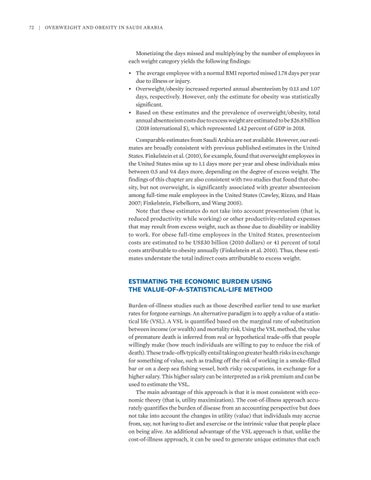72
|
Overweight and Obesity in Saudi Arabia
Monetizing the days missed and multiplying by the number of employees in each weight category yields the following findings: • The average employee with a normal BMI reported missed 1.78 days per year due to illness or injury. • Overweight/obesity increased reported annual absenteeism by 0.13 and 1.07 days, respectively. However, only the estimate for obesity was statistically significant. • Based on these estimates and the prevalence of overweight/obesity, total annual absenteeism costs due to excess weight are estimated to be $26.8 billion (2018 international $), which represented 1.42 percent of GDP in 2018. Comparable estimates from Saudi Arabia are not available. However, our estimates are broadly consistent with previous published estimates in the United States. Finkelstein et al. (2010), for example, found that overweight employees in the United States miss up to 1.1 days more per year and obese individuals miss between 0.5 and 9.4 days more, depending on the degree of excess weight. The findings of this chapter are also consistent with two studies that found that obesity, but not overweight, is significantly associated with greater absenteeism among full-time male employees in the United States (Cawley, Rizzo, and Haas 2007; Finkelstein, Fiebelkorn, and Wang 2005). Note that these estimates do not take into account presenteeism (that is, reduced productivity while working) or other productivity-related expenses that may result from excess weight, such as those due to disability or inability to work. For obese full-time employees in the United States, presenteeism costs are estimated to be US$30 billion (2010 dollars) or 41 percent of total costs attributable to obesity annually (Finkelstein et al. 2010). Thus, these estimates understate the total indirect costs attributable to excess weight.
ESTIMATING THE ECONOMIC BURDEN USING THE VALUE-OF-A-STATISTICAL-LIFE METHOD Burden-of-illness studies such as those described earlier tend to use market rates for forgone earnings. An alternative paradigm is to apply a value of a statistical life (VSL). A VSL is quantified based on the marginal rate of substitution between income (or wealth) and mortality risk. Using the VSL method, the value of premature death is inferred from real or hypothetical trade-offs that people willingly make (how much individuals are willing to pay to reduce the risk of death). These trade-offs typically entail taking on greater health risks in exchange for something of value, such as trading off the risk of working in a smoke-filled bar or on a deep sea fishing vessel, both risky occupations, in exchange for a higher salary. This higher salary can be interpreted as a risk premium and can be used to estimate the VSL. The main advantage of this approach is that it is most consistent with economic theory (that is, utility maximization). The cost-of-illness approach accurately quantifies the burden of disease from an accounting perspective but does not take into account the changes in utility (value) that individuals may accrue from, say, not having to diet and exercise or the intrinsic value that people place on being alive. An additional advantage of the VSL approach is that, unlike the cost-of-illness approach, it can be used to generate unique estimates that each






